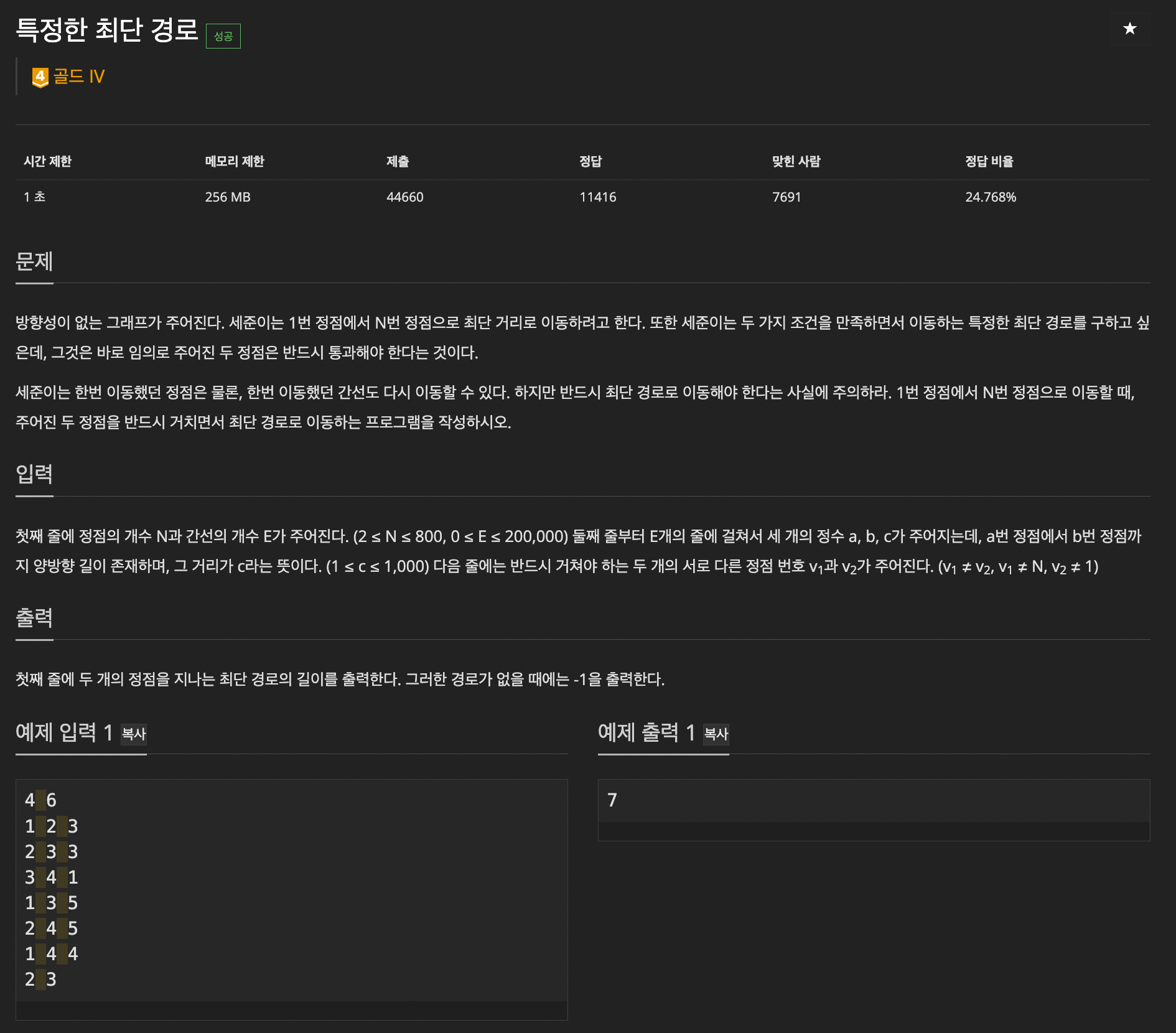
https://www.acmicpc.net/problem/1504
1. 아이디어
case 1) 1번 노드 -> v1 노드 -> v2 노드 -> n번 노드
- 1번 노드 -> v1 노드 최단경로 다익스트라
- v1 노드 -> v2 노드 최단경로 다익스트라
- v2 노드 -> n번 노드 최단경로 다익스트라
case 2) 1번 노드 -> v2 노드 -> v1 노드 -> n번 노드
- 1번 노드 -> v2 노드 최단경로 다익스트라
- v2 노드 -> v1 노드 최단경로 다익스트라
- v1 노드 -> n번 노드 최단경로 다익스트라
=> 2가지 case 중에서 최소 값
1) 시작 지점에 대한 비용 배열, 우선순위 큐 초기화
2) 우선순위 큐가 empty 할 때까지, 다음을 반복
-
우선순위 큐에서 가중치가 가장 낮은 노드를 꺼냄
-
꺼낸 노드와 연결된 다음 노드들에 대해,
다음을 비교하여 갱신 및 우선순위 큐에 추가
① 현재까지 갱신된 시작 노드 -> 다음 노드 경로의 비용 배열 값
② 시작 노드 -> 현재 노드 (경유) -> 다음 노드 경로의 비용
2. 자료구조
int[] dist: 각 최단경로 다익스트라에서 시작 지점 -> 목표 지점의 최단경로 길이PriorityQueue<Node>: 경로 길이 작은 순으로 정렬List<Node>[],ArrayList<Node>[]: 인접 리스트
3. 시간 복잡도
- 다익스트라 시간 복잡도: O(E log_2 V)
=> E, V 최대값 대입: (2 x 10^5) x log_2 (2 x 20^2)
= (2 x 10^5) x ( log_2 + log_2 20^2 )
~= (2 x 10^5) x 10 = 2 x 10^6 << 1억
코드
import java.io.*;
import java.util.*;
class Node implements Comparable<Node> {
public int v; // 정점
public int w; // 시작 정점 -> 정점 v 까지의 경로 길이
public Node(int v, int w) {
this.v = v;
this.w = w;
}
public int compareTo(Node n) {
return this.w - n.w;
}
}
public class Main {
static int n, e; // 정점 개수 n, 간선 개수 e
static int v1, v2; // 반드시 거쳐야 하는 두 정점 v1, v2
static List<Node>[] lists; // 인접 리스트
static int minCount; // 출력, 최단경로 길이
static final int INF = 200_000_000; // 간선 최대 개수(2 x 10^5) x 최대 가중치(10^3)
static int[] dist; // 각 최단경로 길이
static PriorityQueue<Node> pq = new PriorityQueue<>();
static void solution() {
// 1번 노드 -> v1 노드 -> v2 노드 -> n번 노드
int case1 = dijkstra(1, v1) + dijkstra(v1, v2) + dijkstra(v2, n);
// 1번 노드 -> v2 노드 -> v1 노드 -> n번 노드
int case2 = dijkstra(1, v2) + dijkstra(v2, v1) + dijkstra(v1, n);
if (case1 >= INF && case2 >= INF) // 해당 경로로 갈 수 없는 경우
minCount = -1;
else
minCount = Math.min(case1, case2);
}
/* startV -> destV 로의 최단경로 길이 반환 */
static int dijkstra(int startV, int destV) {
// 1) 비용 배열, 우선순위 큐 초기값
Arrays.fill(dist, INF);
dist[startV] = 0;
pq.add(new Node(startV, 0));
// 2) 비용 배열 갱신 및 우선순위 큐에 추가
while (!pq.isEmpty()) {
Node current = pq.remove();
// 이미 현재 지점까지로의 최단경로가 갱신된 경우는 제외
if (dist[current.v] < current.w)
continue;
// 현재 노드 current.v 와 연결된 다음 노드 next
for (Node next : lists[current.v]) {
// dist[next.v]: 현재까지 갱신된 시작 노드 -> next.v 노드까지의 최단거리
// dist[current.v] + next.w: 시작 노드 -> current.v 노드 -> next.v 노드 거리
if (dist[next.v] > dist[current.v] + next.w) {
dist[next.v] = dist[current.v] + next.w;
pq.add(new Node(next.v, dist[next.v]));
}
}
}
return dist[destV];
}
public static void main(String[] args) throws IOException {
BufferedReader br = new BufferedReader(
new InputStreamReader(System.in)
);
StringTokenizer st = new StringTokenizer(br.readLine());
n = Integer.parseInt(st.nextToken());
e = Integer.parseInt(st.nextToken());
dist = new int[n + 1]; // [1] ~ [n] 사용
lists = new ArrayList[n + 1];
for (int i = 1; i <= n; i++)
lists[i] = new ArrayList<>();
for (int i = 0; i < e; i++) {
st = new StringTokenizer(br.readLine());
int a = Integer.parseInt(st.nextToken()); // 출발 v
int b = Integer.parseInt(st.nextToken()); // 도착 v
int c = Integer.parseInt(st.nextToken()); // 길이
lists[a].add(new Node(b, c));
lists[b].add(new Node(a, c));
}
st = new StringTokenizer(br.readLine());
v1 = Integer.parseInt(st.nextToken());
v2 = Integer.parseInt(st.nextToken());
solution();
System.out.println(minCount);
}
}